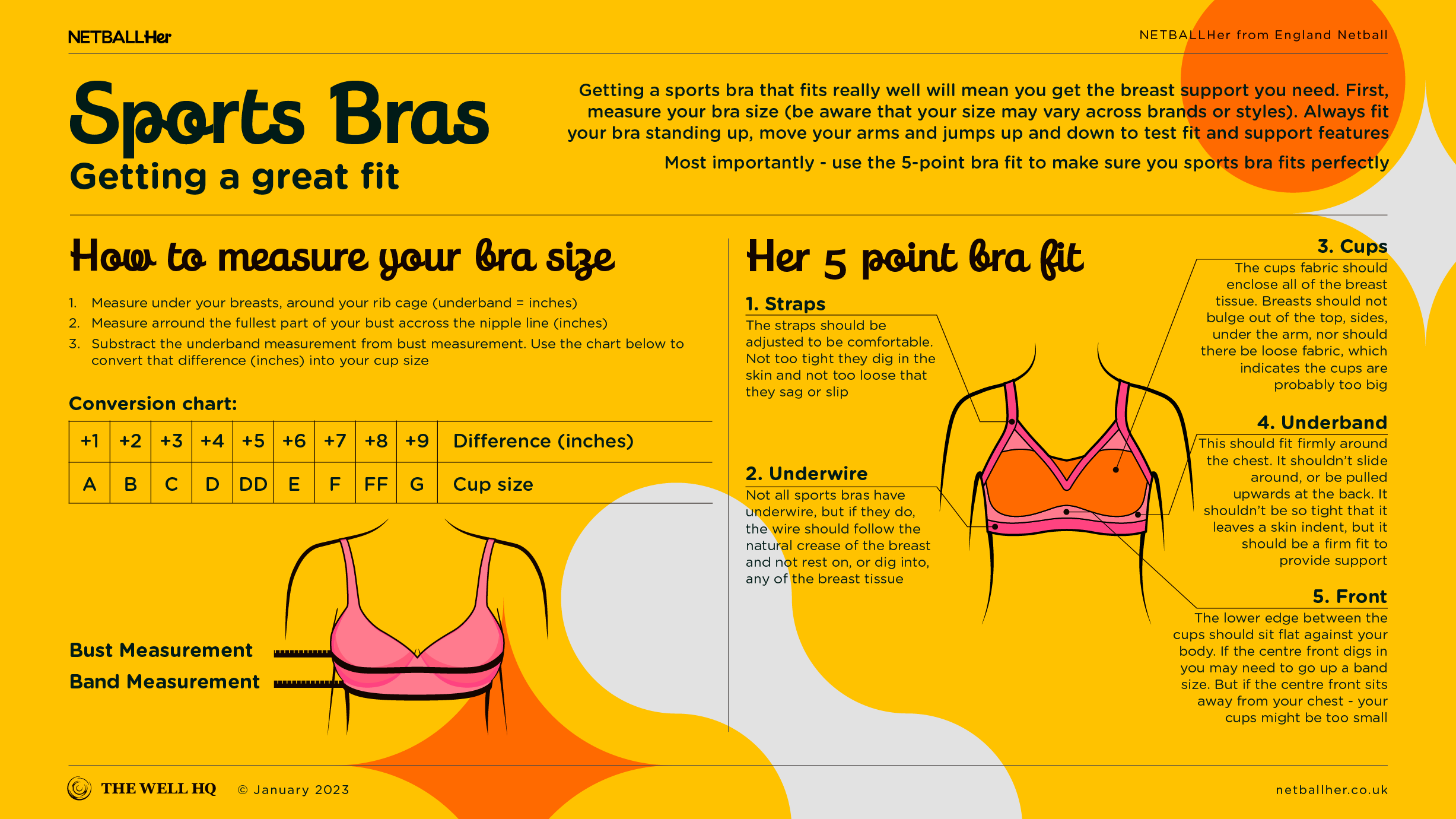Click play for an audio readthrough of this article
A well-fitting sports bra’s a no-brainer. Here’s why
A well-fitted sports bra can improve your performance by 4%.
Four. Per. Cent.
We love this stat. And any time we share it with active women – whatever their age, stage or sport – we get the classic you’re kidding? look.
Not kidding though. Any performance coach anywhere in the world over would pay top dollar for 4% gains, but here it is on offer … for the price of a well-fitted sports bra.
How’s that possible? Well, you first need to get to know your breasts and the many drawbacks of a bad bra.
What’s in a breast?
The female breast is basically a blob made mostly of fat, glands and milk ducts. There’s no muscle or bone and just a small structure of connective tissue helps to keep its shape.
Although the ribs and pectoral muscles sit behind, they don’t hold breasts in place. Skin does. Just skin. And since skin is elastic, it doesn’t provide much support at all against breast movement.
Sport and breasts
When women move, our breasts move. The bigger the breasts the more the movement. The movement is greater still when breasts aren’t well supported.
Researchers in the field have found that even an average-sized breast moves up to 20 centimetres during intense exercise, such as running and jumping, and up to 15 centimetres in less intense exercise – such as jogging.
Also, breasts typically weigh about half a kilogram each, so consistent loads of weight and motion on badly supported breasts can quickly cause pain and discomfort.
Think about netball. All that running, jumping, jerking, stopping, starting, motion … that’s a lot of movement and pressure on parts of your body that are, essentially, hanging on by a few threads. It’s a recipe for injury, pain, and many other problems besides.
If you wear a bad bra, that is …
The impact of a poorly-fitting bra
There is a whole field of research dedicated to understanding how breasts move during sport, and what impact that might have on our experience of exercise, and our performance. These researchers have made some really insightful findings about the impact of wearing a sports bra which does not provide you with the support you need. The exciting prospect is that for every issue that a poorly fitting bra creates, a brilliantly fitting bra provides you with the alternate opportunity to improve your Netball experience!
Here’s a rundown of just how breast movement, which happens if you aren’t in a well fitting, supportive sports bra, can impact us when we do sport:
Makes exercise feel harder
Run with poor breast support and your upper body muscles have to work harder to counteract the effects of your moving breasts. Harder working muscles equals more energy expended so you’ll tire faster than you would in a better bra. In other studies, which ask women to rate how hard exercise feels whilst running at a given speed on the treadmill, with higher levels of breast support women felt that the running effort was easier, compared to rating exercise as more intense, when running at the same speed in a lower support bra.
Messes with your breathing
Research shows women breathe differently when breasts are poorly supported. Basically, a woman holds in breaths for longer as if to brace herself for the movement of her breasts.
This is problematic for two key reasons: 1) less air in equals less oxygen flow and that’ll accelerate feeling tired. 2) the brain picks up on our breathing to calculate how hard the body’s working. Hard work but fewer breaths sends a mixed signal … and that disconnect can make exercise feel like a major slog.
Shortens your stride
Here’s one I love: imagine you’re about to run a marathon. At the start line next to you is an exact clone of you. Her physiology, her training, her pre-race meal … she is similar to you in every conceivable way except one: she’s wearing a well-fitted sports bra and you’re not.
What’ll happen? She’ll finish a mile ahead of you.
A mile!? Yes. Bad-bra-you will compensate for additional breast movement by slightly shortening your stride. Pace by pace the difference is negligible – tiny – yet over the course of a marathon it adds up, hence you’ll be a mile in the rear-view-mirror when clone-you crosses the finish line.
Just because we don’t run marathons on a netball court, we do rely on our stride length to make that interception, or move into space. We also cover a whopping 10km on the netball court, so plenty of distance to be impacted by a change to your stride if you are wearing a poorly fitting or less-supportive bra.
It ups your general injury risk
When running, breasts go up and down; side to side; forward and back. These motions create a force which transfers through the whole body right down to the ground. The interference with these usually finely tuned forces can become another risk factor in sustaining an injury.
It increases breast injury risk
No one talks much about breast injuries but, from contact injuries to skin injuries, they’re very real. In a study of 500 elite female athletes representing 46 different sports, more than one in three (36%) reported suffering breast injuries and one in five (21%) said those injuries negatively affected performance.
Contact sports, including netball, would benefit from more protection yet products in the body armour category are typically designed for men and rarely for breasts (although, check out Boob Armour). But there are now inserts which can be slipped inside your sports bra, which do protect against breast injury.
On skin injuries: imagine your netball trainers caused blistering, rubbing and chaffing. You’d bin them, right? Ditto, if the trainers dug into your skin, leaving furrows and compressing your nerves … you’d turf them quicksmart.
Ill-fitting bras can do all of the above, yet too many of us accept this as an inevitable and / or unfixable problem. It’s not.
Poor fit is the problem and the fix is relatively simple.
Musculoskeletal problems
Poorly fitting bras are linked to musculoskeletal problems, including tension, tightness and pain in the back, shoulders and neck.
Some physios actually prescribe well-fitting bras as a treatment; a way to relieve pain and fix postural problems.
Do my big boobs mean I can’t?
We get asked a lot whether breast size matters. And to a limited extent it does.
There is evidence that larger breasts move more than smaller ones, and that breast pain is more frequent in women who have larger breasts. Breast pain is also a key reason given by larger-breasted women as to why they shun / gave up exercise.
But big boobs shouldn’t be a barrier. This is a world where Serena Williams has dominated tennis for a generation. Like other large-breasted athletes, Serena had to shop around with more trial and error before she settled on a sports bra she loved. But she found hers and hasn’t ever looked back. You can too.
The next best article for you is how to support your breasts well. Because you can. Anyone can.
As a reminder, the content of the course belongs to The Well HQ. You have permission to access and use the content yourself or, if you are an organisation, for the number of users selected, but are not otherwise permitted to share such content with others, all in accordance with our Course Terms and Conditions.

